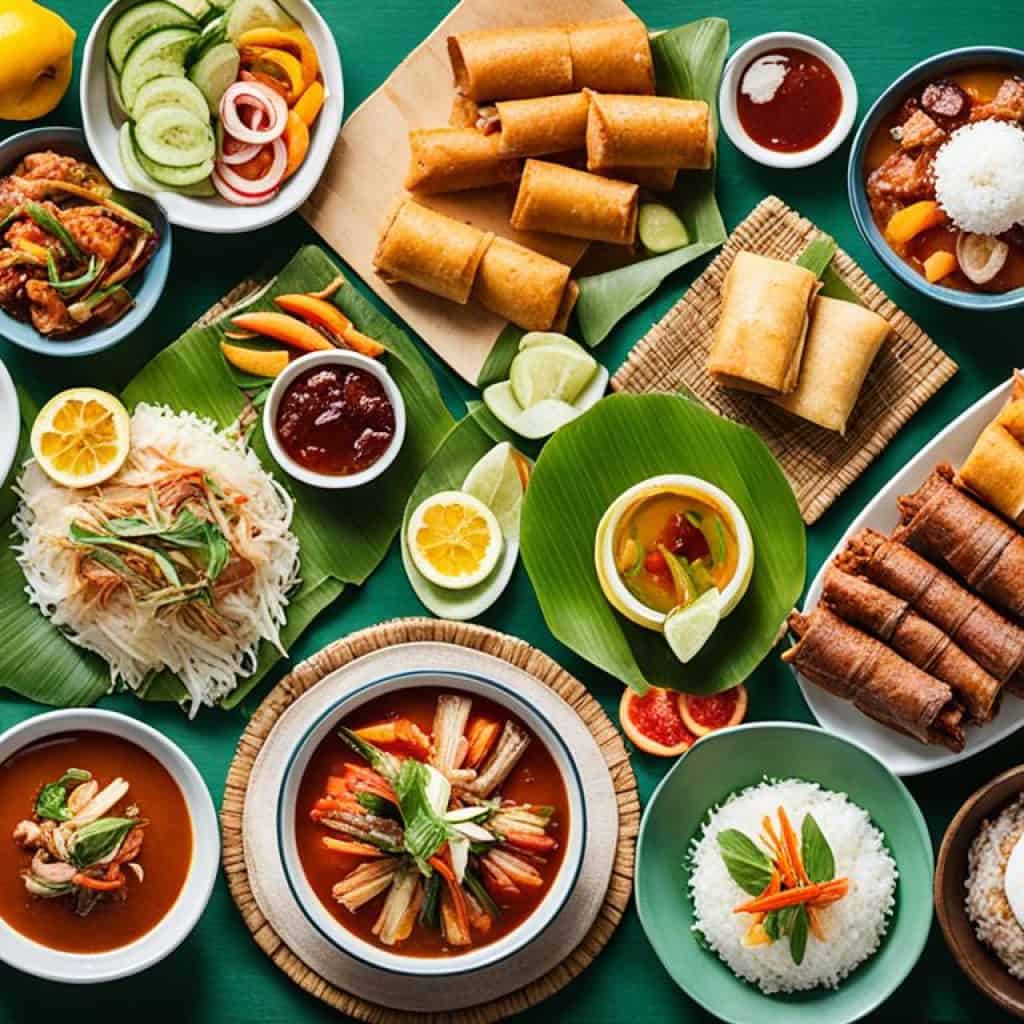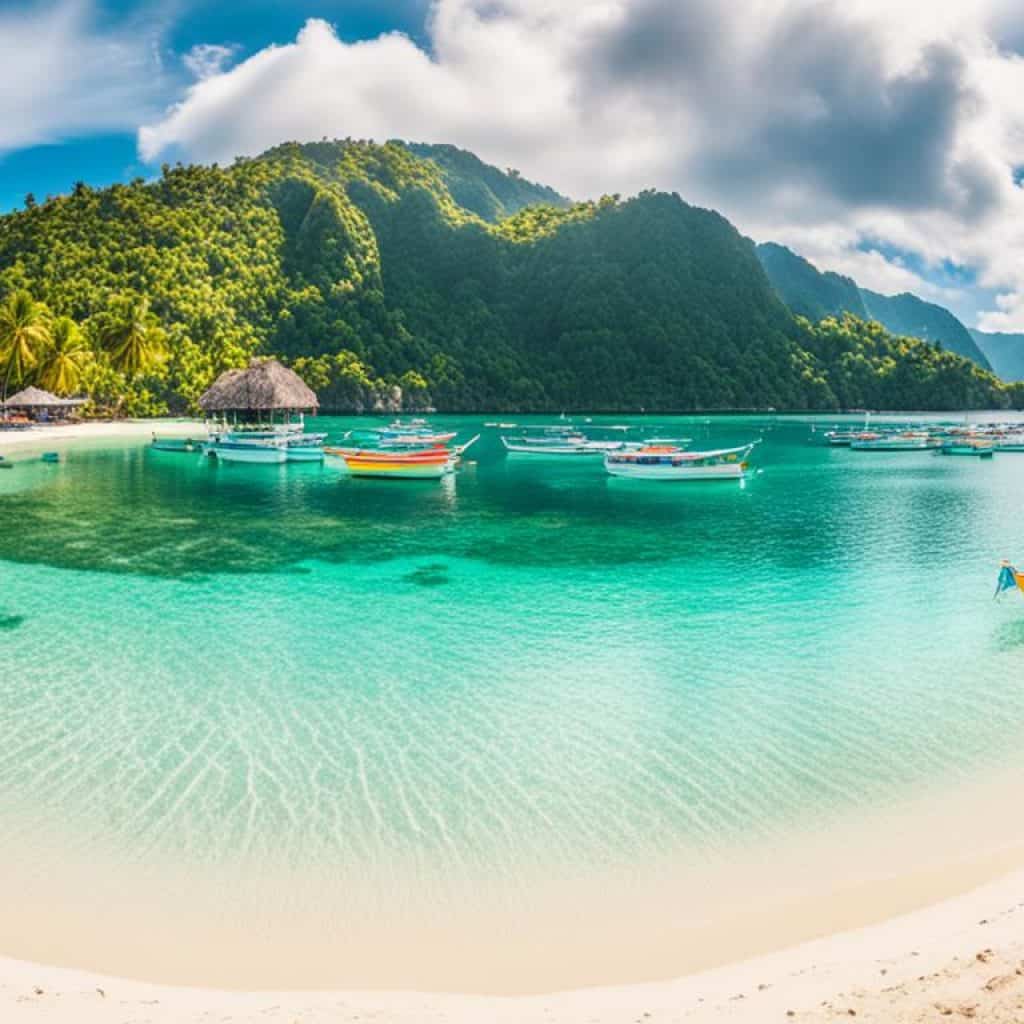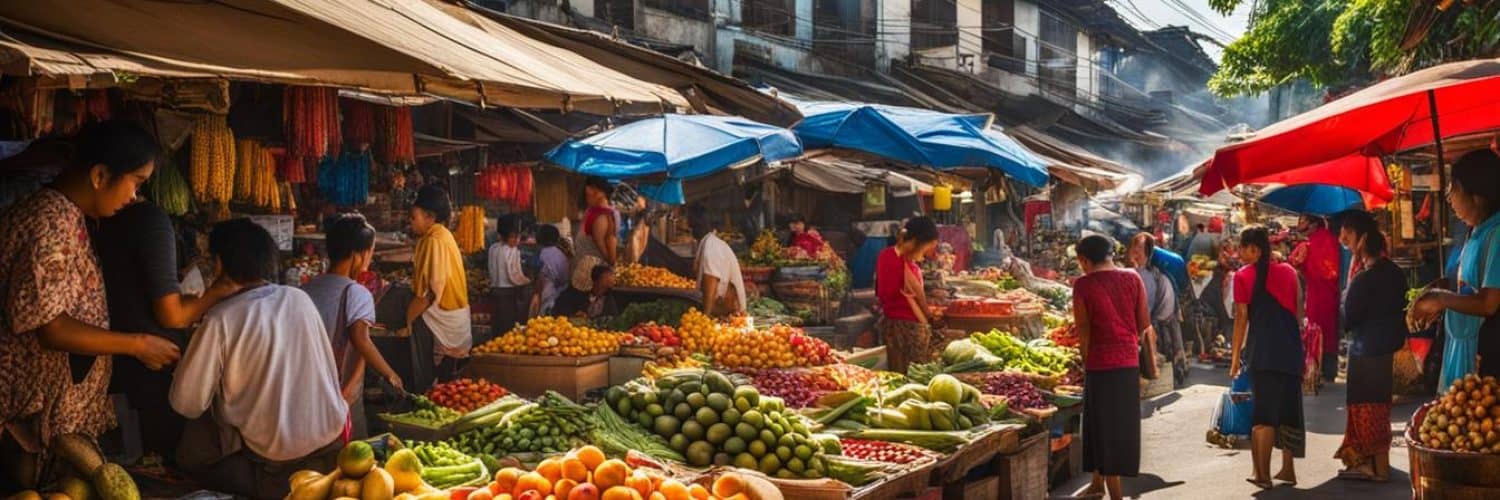Are you curious about the Philippines’ vibrant culture, picturesque landscapes, and unique way of life? Living in the Philippines offers a window into a tropical paradise teeming with friendly locals, mouth-watering cuisine, and a relaxed lifestyle. But what exactly is it like to call this enchanting archipelago home? Let’s dive in and explore the Philippines lifestyle and the rich tapestry of Philippine culture.
Key Takeaways:
- The Philippines offers an affordable cost of living, making it an attractive destination for expats.
- There is a wide range of accommodation options, from condos in Manila to guest houses in other parts of the country.
- Experience a gastronomic adventure with Filipino cuisine, known for its unique flavors and dishes.
- Connectivity has improved in recent years, making the Philippines suitable for digital nomads and remote workers.
- While the healthcare system may have some limitations, expats can secure private insurance for medical services.
Cost of Living in the Philippines
The cost of living in the Philippines is relatively low compared to many other countries, making it an attractive destination for those seeking affordable living. Whether you’re considering retirement or looking to relocate, the Philippines offers a range of living expenses that can fit different budgets.
Other Expenses:
- Commute: Public transportation, such as buses and jeepneys, is an affordable option for getting around in the Philippines.
- Communication: Purchasing a SIM card for your mobile phone is a cost-effective way to stay connected with friends and family.
- Groceries: Buying groceries from local markets can help stretch your budget further, as they often offer fresh produce and ingredients at lower prices.
Overall, the cost of living in the Philippines allows for a comfortable and affordable lifestyle, especially when compared to many Western countries.
Discover the affordable living expenses of the Philippines and enjoy a comfortable lifestyle without sacrificing quality.
Accommodation in the Philippines
In the bustling capital city of Manila, condo living is a popular choice for expats and locals alike. These modern apartments often come with amenities such as swimming pools, gyms, and 24-hour security. Renting a one-bedroom condo in Manila can cost around £500 per month, offering a convenient and comfortable living space.
If you’re exploring other parts of the country, guest houses and small hotels are common accommodation choices. These options provide a more intimate and authentic experience, allowing you to immerse yourself in the local culture. Guest houses are especially popular in tourist destinations and offer a unique opportunity to connect with fellow travelers.
For those planning to stay for an extended period, long-term rentals are available in big cities like Manila. These rentals offer the comfort and convenience of a home, often with fully furnished units and flexible lease terms. Western-style apartments are also an option, providing you with a taste of familiar living with amenities like rooftop pools, gyms, and breathtaking views.
When it comes to finding the right accommodation in the Philippines, it’s important to consider your preferred location, budget, and lifestyle. Whether you choose a stylish apartment in Manila or a cozy guest house in a provincial town, you’ll have the opportunity to experience the warmth and hospitality of the Filipino people.
Food and Cuisine in the Philippines
The Philippines is a culinary paradise, offering a diverse mix of flavors and influences. From traditional Filipino dishes to international cuisine, there is something to satisfy every palate. Let’s take a closer look at the enticing world of Filipino food and dining options in the Philippines.
Filipino Cuisine: A Delightful Fusion
Filipino cuisine is a captivating blend of indigenous flavors and foreign influences. It reflects the country’s rich cultural history, incorporating elements from Spain, China, Malaysia, and the United States. The result is a fascinating amalgamation of tastes and textures that will leave you craving for more.
One of the iconic Filipino dishes is adobo. This beloved stewed meat dish is cooked in a delicious blend of soy sauce and vinegar, resulting in a uniquely tangy and savory flavor. Another must-try is kare-kare, an oxtail stew infused with a rich and creamy peanut sauce.
“Filipino cuisine is a delightful fusion of flavors, appealing to both adventurous eaters and those seeking comfort in familiar tastes.”
Dining Options: A Culinary Adventure
In the Philippines, dining options abound, catering to every taste and budget. From street food stalls to high-end restaurants, the choices are vast and varied.
For an authentic Filipino dining experience, exploring local markets and street food vendors is a must. Indulge in the mouthwatering aroma of grilled skewers or satisfy your sweet tooth with sticky rice cakes and fresh tropical fruits.
If you are in the bustling capital city of Manila, you will find a wide array of international culinary delights. From Japanese sushi bars to Italian trattorias and American burger joints, the cosmopolitan city offers a global gastronomic experience.
| Cuisine | Highlights | Recommended Restaurants |
|---|---|---|
| Japanese | Sushi, sashimi, and ramen | Yabu: House of Katsu, Ooma |
| Korean | Barbecue, bibimbap, and kimchi | Samgyupsalamat, Kko Kko |
| Italian | Pizza, pasta, and gelato | Trattoria Gourmet |
| American | Burgers, steaks, and milkshakes | 8 Cuts Burger Blends, Shake Shack |
Whether you’re in the mood for traditional Filipino fare or international cuisine, the Philippines offers a vibrant culinary scene that will tempt and tantalize your taste buds.

With its captivating fusion of flavors and a wide array of dining options, the food scene in the Philippines is a delightful journey for food enthusiasts. From savoring traditional Filipino dishes like adobo and kare-kare to exploring international cuisines in bustling city restaurants, the Philippines offers a gastronomic adventure that shouldn’t be missed.
Internet and Connectivity in the Philippines
Living in the digital age, access to high-speed internet and reliable connectivity is crucial, especially for digital nomads and remote workers. In recent years, the internet infrastructure in the Philippines has improved significantly, providing better access to online resources and communication channels. Many cities, including the bustling capital Manila, offer high-speed internet and 4G connectivity that rival other developed countries.
This improvement in internet and connectivity has made the Philippines an attractive destination for digital nomads seeking a balance between work and leisure. With the availability of fast and reliable internet connection, remote workers can carry out their professional tasks efficiently and seamlessly.
However, it is important to note that there may still be areas, particularly in rural or remote locations, where internet speeds may be slower or less stable. While these areas provide tranquil settings and untouched natural beauty, they may not be ideal for those who depend heavily on internet access for their work or personal needs.
If you rely on WiFi in your daily activities or work as a digital nomad, it is advisable to research and choose your location wisely. Consider cities or regions that have well-established internet infrastructure to ensure a smooth and uninterrupted online experience.
WiFi in the Philippines
WiFi is widely available in the Philippines, particularly in urban areas and popular tourist destinations. Hotels, cafes, restaurants, and co-working spaces often offer free WiFi access to their customers. This allows digital nomads and visitors to stay connected while exploring the vibrant culture and breathtaking landscapes of the country.
Whether you’re grabbing a cup of coffee or unwinding on a beach, accessing WiFi is convenient and hassle-free. It provides the flexibility to work remotely or stay connected with loved ones from anywhere in the Philippines.
Hotspots for Digital Nomads
The Philippines boasts several cities that have emerged as hotspots for digital nomads seeking a blend of work opportunities and quality of life. Some popular destinations for digital nomads include:
- Cebu City: Known for its lively atmosphere and coworking spaces.
- Makati: The financial hub of the Philippines, offering a vibrant business environment.
- Boracay: A tropical paradise with a laid-back vibe and stunning beaches.
- Palawan: A nature lover’s paradise with serene islands and crystal-clear waters.
These locations provide a conducive environment for digital nomads, with a mix of modern infrastructure, affordable living costs, and a thriving expat community.
“The Philippines offers a unique opportunity for digital nomads to experience the beauty of island living while staying connected. With the availability of fast internet and WiFi hotspots, digital nomads can work remotely without compromising on lifestyle.”
Overall, the Philippines provides a favorable environment for digital nomads and remote workers with its improving internet infrastructure, WiFi availability, and attractive destinations. Whether you’re looking to escape the traditional office setting or explore new horizons as a digital nomad, the Philippines offers a compelling destination to live, work, and immerse yourself in its rich culture and natural wonders.
Healthcare in the Philippines
Public healthcare in the Philippines is limited, with overcrowded hospitals and long waiting times. As a result, many people, including expats, rely on private insurance for medical services. Private hospitals and clinics offer a higher standard of care and shorter waiting times, making them a favorable choice for those seeking timely and efficient treatment.
Expats are encouraged to obtain comprehensive health insurance coverage that includes medical evacuation, as well as coverage for pre-existing conditions, prescription medications, and specialist consultations. This ensures that expats have access to a wide range of medical services without the burden of high out-of-pocket expenses.
Although the cost of healthcare in the Philippines is generally lower than in other countries, it is still essential to have insurance coverage to mitigate any unexpected medical expenses. Expats should also be aware of the location and accessibility of healthcare facilities within their vicinity to ensure prompt medical attention when needed.
Private Hospitals and Medical Facilities
Private hospitals in the Philippines offer a range of specialized medical services and state-of-the-art facilities. These hospitals are equipped to handle complex medical procedures and emergencies, ensuring that expats receive the care they need. Some well-known private hospitals include:
- Makati Medical Center
- St. Luke’s Medical Center
- Asian Hospital and Medical Center
The table below highlights the key features of these private hospitals:
| Hospital | Location | Specialties | Facilities |
|---|---|---|---|
| Makati Medical Center | Makati City | Cardiology, Oncology, Neurology | 24/7 Emergency Services, Operating Theaters, Diagnostic Centers |
| St. Luke’s Medical Center | Quezon City, Taguig City | Heart Center, Cancer Institute, Neuroscience Center | Advanced Diagnostic Imaging, Surgical Suites, Intensive Care Units |
| Asian Hospital and Medical Center | Muntinlupa City | Orthopedics, Gastroenterology, Women’s Health | Specialty Clinics, Rehabilitation Center, Laboratory Services |
These private hospitals offer a wide range of medical specialties and have modern facilities to cater to the needs of expats and locals alike. It is always advisable to check with your insurance provider to ensure that these hospitals are covered by your policy.
In addition to private hospitals, the Philippines also has numerous clinics and specialized medical facilities that provide services such as dental care, dermatology, and fertility treatments. These clinics offer a more affordable alternative for non-emergency medical needs.
Expats residing in the Philippines should be proactive about their healthcare needs by staying up to date with vaccinations and preventive screenings. It is also essential to establish a good relationship with a trusted primary care physician who can provide comprehensive medical care and referrals to specialists when necessary.
Things to Do and Places to Visit in the Philippines
With over 7,000 islands, the Philippines offers a plethora of incredible experiences and breathtaking destinations for both tourists and residents. Whether you’re an adventure seeker or a nature lover, this tropical paradise has something to offer everyone. From thrilling diving and surfing spots to picturesque hiking trails and awe-inspiring photography opportunities, the Philippines is a haven for exploration and discovery.
One of the most renowned destinations in the Philippines is Palawan, often described as paradise on earth. With its crystal-clear waters, stunning limestone cliffs, and vibrant marine life, Palawan is a dream come true for beach lovers and water sport enthusiasts. It is home to the enchanting Puerto Princesa Subterranean River National Park, a UNESCO World Heritage Site and one of the New 7 Wonders of Nature.
If you’re looking for an off-the-beaten-path experience, head to Siargao Island. This laid-back paradise in the province of Surigao del Norte is known as the surfing capital of the Philippines. Its world-class waves attract surfers from around the globe, making it a haven for adrenaline junkies. But Siargao is not just about surfing; it also boasts pristine beaches, lagoons, and a vibrant nightlife that will surely captivate any visitor.
Another must-visit destination in the Philippines is Cebu. This bustling province is a perfect blend of natural wonders and rich cultural heritage. Immerse yourself in history by visiting the famous Magellan’s Cross and Fort San Pedro, or take a dip in the turquoise waters of Kawasan Falls. For those seeking a unique and immersive experience, don’t miss the chance to swim with whale sharks in Oslob.
The Philippines offers an endless array of activities and destinations that will leave you in awe. Whether you’re exploring the charming streets of Vigan, marveling at the Chocolate Hills in Bohol, or taking a scenic hike up Mount Pinatubo, you’ll never run out of incredible experiences in this tropical paradise.

So pack your bags, grab your camera, and get ready to embark on the adventure of a lifetime. The Philippines awaits, ready to unveil its beauty and charm at every turn.
Embracing the Filipino Lifestyle and Culture
Living in the Philippines means immersing yourself in the vibrant Filipino lifestyle and embracing its rich cultural experiences. The country’s diverse traditions and warm hospitality create a unique and fulfilling living experience.
Festivals are a wonderful way to celebrate the Filipino spirit and immerse yourself in the local culture. From the colorful Sinulog Festival in Cebu to the lively Pahiyas Festival in Lucban, these events showcase the traditions, customs, and creativity of the Filipino people. Participating in these festivities allows you to gain a deeper understanding of the values and beliefs that shape Filipino society.
But it’s not just the big festivals that offer cultural experiences. Daily life in the Philippines is infused with traditions that highlight the strong connection to heritage and community. From the Bayanihan spirit of helping neighbors to the respect for elders and close-knit family ties, these customs create a sense of unity and warmth.
Living in the Philippines gives you the opportunity to witness the blending of cultures and traditions that make up the fabric of Filipino society. It’s a constant reminder of the richness of human diversity and the beauty of shared experiences.
The Filipino lifestyle is one that cherishes relationships and embraces a laid-back approach to life. Spending time with loved ones, enjoying delicious meals together, and engaging in lively conversations are integral parts of daily life. The emphasis on connection and camaraderie fosters a strong sense of belonging and community.
Beyond the festivals and traditions, exploring the natural wonders of the Philippines is another way to experience its unique culture. From the famous Banaue Rice Terraces to the stunning beaches of Boracay, each destination offers a glimpse into the country’s breathtaking landscapes and natural treasures.
Experience the Richness of Filipino Culture
Here are a few ways to truly embrace the Filipino lifestyle and culture:
- Participate in local festivals and events
- Try traditional Filipino dishes such as adobo, sinigang, and lechon
- Learn a few Filipino phrases and greetings
- Visit historical sites and museums to learn about the country’s past
- Engage with the local community and learn about their customs and traditions
By immersing yourself in the Filipino lifestyle and culture, you’ll gain a deeper appreciation for the country and its people. The Philippines offers a rich tapestry of experiences that will leave a lasting impression on your heart and soul.
| Traditions | Cultural Experiences | Benefits |
|---|---|---|
| Festivals | Participating in colorful and lively festivals | Deepens cultural understanding and fosters community spirit |
| Traditional Customs | Engaging with local customs and showcasing respect for community | Strengthens bonds and promotes a sense of belonging |
| Shared Meals and Gatherings | Enjoying delicious food and engaging in lively conversations | Promotes connection and fosters a strong sense of community |
| Exploring Natural Wonders | Discovering the beauty of the Philippines’ breathtaking landscapes | Provides insight into the country’s rich natural heritage |
Safety and Security in the Philippines
When it comes to safety in the Philippines, expats and tourists should be aware of the country’s unique security landscape. While the Philippines is generally a safe destination, like any other country, it is important to take necessary precautions to ensure your personal safety and security.
Avoiding high-crime areas and being aware of your surroundings is essential. Urban areas in the Philippines, especially densely populated cities like Manila, may have higher crime rates compared to rural areas. However, exercising caution can significantly mitigate any potential risks.
Here are some tips to enhance your safety and security in the Philippines:
- Research and familiarize yourself with the areas you plan to visit or live in. Understand the local laws, customs, and cultural norms.
- Use reputable transportation services and avoid traveling alone, especially at night.
- Keep your personal belongings secure and be cautious of pickpocketing or theft in crowded areas.
- Stay connected with friends, family, or local contacts. Inform them of your whereabouts and establish regular check-ins.
- Consider joining expat groups or forums to connect with other expats and gain insights into local safety tips.
- If you encounter any safety concerns or emergencies, contact the local authorities or your embassy for assistance.
While it’s important to be cautious and proactive about your safety, it’s also essential to remember that the majority of people in the Philippines are friendly, welcoming, and helpful towards expats and tourists. By being respectful of the local culture and employing common-sense safety measures, you can experience the beauty and warmth of the Philippines without compromising your security.
Education and Schools in the Philippines
When considering a move to the Philippines, one important aspect to think about is the education system. The country offers a combination of public and private schools, as well as international schools that cater to expat families. It is essential for families with children to research and choose reputable schools that meet their needs.
The quality of education in the Philippines can vary, which is why it’s crucial to thoroughly evaluate schools before making a decision. Many private schools boast small class sizes, dedicated teachers, and a well-rounded curriculum. International schools, in particular, provide an excellent option for expat families seeking an education that follows a familiar educational system and offers a diverse student body.
These schools typically follow international curricula such as the American, British, or International Baccalaureate program. Besides providing a high standard of education, international schools often offer additional support services tailored to the needs of expat students, such as English as a Second Language (ESL) programs.
“The education system in the Philippines offers a unique opportunity for expat families to immerse their children in a multicultural learning environment while ensuring a quality education. With a variety of options available, families can find schools that align with their educational philosophy and goals.”
Researching and visiting potential schools is a crucial step in ensuring a smooth transition for children. Parents should consider factors like proximity to their residence, extracurricular activities, and the availability of support services.
Table: Overview of Education System in the Philippines
| Type of School | Key Features |
|---|---|
| Public Schools | – Government-funded – Mainstream curriculum – Large class sizes |
| Private Schools | – Fee-paying – Variable curriculum – Smaller class sizes |
| International Schools | – Follow international curricula – Diverse student body – Tailored support services for expat students |
Parents should also consider the location of the school, as larger cities like Manila often have a wider range of educational opportunities. However, smaller towns and provinces may still offer high-quality education options.
Overall, the education system in the Philippines is diverse and provides opportunities for students to grow academically and culturally. Whether attending public, private, or international schools, students will have the chance to experience a different education system while embracing the rich Filipino culture.
Transportation in the Philippines
When it comes to getting around in the Philippines, there are several modes of transportation to choose from. Whether youâre traveling within the city or exploring different islands, the country offers a variety of options to suit your needs.
Public Transportation
Public transportation in the Philippines is both affordable and convenient. Buses, jeepneys, tricycles, and taxis are readily available in most areas, making it easy to navigate through cities and towns. These modes of transport are preferred by locals and tourists alike, as they provide an authentic experience of Filipino culture and allow you to interact with the friendly locals.
However, itâs important to note that traffic congestion can be a challenge, especially in urban areas. Planning your travel accordingly, especially during rush hours, can help you avoid unnecessary delays.
Commuting in the Philippines
Commuting in the Philippines involves navigating through a network of transportation options. Depending on your location, you may need to take multiple modes of transport to reach your destination. For example, you can take a jeepney or tricycle to get to the nearest bus or train station.
Here’s a quick overview of popular modes of public transportation in the Philippines:
| Mode of Transportation | Features |
|---|---|
| Jeepneys | – Colorful and iconic public buses – Affordable fares – Communal seating – Regular routes within cities and towns |
| Tricycles | – Small motorized vehicles – Can accommodate up to three passengers – Commonly used for short distances and local trips – Fares are negotiated with the driver |
| Buses | – Different types available, from ordinary to air-conditioned – Cover long-distance routes – Varying rates depending on the class of service |
| Taxis | – Metered or fixed rates – Widely available in urban areas – Generally more expensive than other modes of transport – Booking via mobile apps also possible |
It’s important to keep in mind that payment methods for public transportation may vary. Cash is the most common form of payment, so having small bills and coins can be helpful. Some ride-hailing services, such as Grab, also operate in major cities, providing an alternative to traditional taxis.
Tip: To make your commute more enjoyable, consider downloading navigation apps or familiarizing yourself with local landmarks and route maps.
With a bit of planning and flexibility, you can easily navigate the transportation system in the Philippines and explore all that this beautiful country has to offer.
Expats' Experiences and Integration in the Philippines
Living as an expat in the Philippines offers a unique opportunity to immerse oneself in the vibrant culture and welcoming community. Many expats find it easy to integrate into the Filipino way of life due to the warm and friendly nature of the locals. The country’s strong expat community further facilitates this process, providing a sense of support and camaraderie.
One of the key factors contributing to a smooth integration is the openness of the Filipino people. Known for their hospitality, Filipinos readily embrace expats and often go out of their way to make them feel at home. Whether it’s inviting expats to join local celebrations or offering assistance in navigating the nuances of daily life, the locals are always eager to extend a helping hand.
Additionally, expat communities thrive in various cities across the Philippines. These communities serve as valuable platforms for socializing, networking, and sharing experiences. Through organized events, gatherings, and online forums, expats have the opportunity to connect with like-minded individuals and build lasting friendships. This sense of belonging plays a significant role in making the expat experience in the Philippines fulfilling and enjoyable.
Adjusting to the local culture is an essential aspect of successful integration. Embracing Filipino customs, traditions, and even learning some Tagalog phrases can help forge deeper connections with the local community. Expats who make an effort to understand and respect the local way of life find themselves more readily accepted as part of the broader Filipino society.
The warm and welcoming nature of Filipinos makes it easy for expats to integrate into the community and embrace the local culture. By actively participating in expat communities and immersing themselves in Filipino traditions, expats can truly make the most of their experience in the Philippines.
Conclusion
Living in the Philippines offers a unique blend of tropical paradise, affordable living, and vibrant cultural experiences. With over 7,000 islands to explore, there is no shortage of beautiful destinations to visit and enjoy. From the stunning beaches of Palawan to the bustling streets of Manila, the Philippines has something for everyone.
While there may be challenges, such as healthcare limitations and occasional safety concerns, these can be managed with proper preparation and caution. Expats should ensure they have adequate health insurance coverage and familiarize themselves with safety precautions in their area. The warm and friendly nature of the Filipino people also contributes to making the Philippines a welcoming and enjoyable place to live.
Overall, expat life in the Philippines offers a unique opportunity to immerse oneself in a vibrant culture, embrace the beauty of nature, and create lasting memories. Whether you are a digital nomad, retiree, or someone seeking a new adventure, the Philippines has much to offer. So, pack your bags, explore the islands, and experience all that this incredible country has in store.
FAQ
What is it like living in the Philippines?
Living in the Philippines offers a vibrant lifestyle with a rich culture and tropical paradise. It is a country known for its affordable cost of living, friendly locals, and a wide variety of island destinations.
What is the cost of living in the Philippines?
What are the accommodation options in the Philippines?
The type of accommodation varies depending on the island. In Manila, condo living is common, while guest houses and small hotels are popular options in other parts of the country. Long-term rentals and Western-style apartments with amenities are also available.
What is the food and cuisine like in the Philippines?
The food in the Philippines is a mix of local dishes and international cuisine. Filipino cuisine includes dishes like adobo and kare-kare. There are also many international food options available, especially in cities like Manila.
What is the internet and connectivity like in the Philippines?
The internet and connectivity in the Philippines have improved in recent years. Many places offer high-speed internet and 4G connectivity, making it an attractive destination for digital nomads and remote workers. However, slower internet speeds may still be experienced in rural or remote locations.
How is the healthcare system in the Philippines?
What are the top things to do and places to visit in the Philippines?
With over 7,000 islands, the Philippines offers a wide range of activities and destinations. From diving and surfing to hiking and photography, there is something for everyone. Popular destinations include Palawan, Siargao, and Cebu.
What is it like embracing the Filipino lifestyle and culture?
Living in the Philippines means embracing the unique Filipino lifestyle and culture. This includes celebrating local festivals, experiencing traditional customs, and appreciating the warm hospitality of the Filipino people. The diverse culture offers a rich cultural experience.
Is the Philippines a safe country for expats and tourists?
While the Philippines has its share of safety concerns, it is generally a safe country. Exercising caution and taking necessary precautions, such as avoiding high-crime areas and being aware of surroundings, is advisable.
What are the education and school options in the Philippines?
The education system in the Philippines includes public and private schools, as well as international schools for expat families. The quality of education can vary, so it is important for families with children to research and choose reputable schools that meet their needs.
What is the transportation system like in the Philippines?
The transportation system in the Philippines includes buses, jeepneys, tricycles, and taxis. Public transportation is affordable and readily available in most areas. However, traffic congestion can be an issue in urban areas, so it is advisable to plan travel accordingly.
How easy is it to integrate into the Filipino community as an expat?
Many expats find it easy to integrate into the Filipino community due to the warm and friendly nature of the locals. There are also expat communities and networking events that provide opportunities to meet other expats. Adjusting to the local culture and way of life can enhance the overall expat experience.
What are the final thoughts on living in the Philippines?
Living in the Philippines offers a unique blend of tropical paradise, affordable living, and vibrant cultural experiences. While there may be challenges, such as healthcare limitations and occasional safety concerns, the overall lifestyle and warmth of the Filipino people make it a desirable destination for those seeking a new adventure.



















Add comment